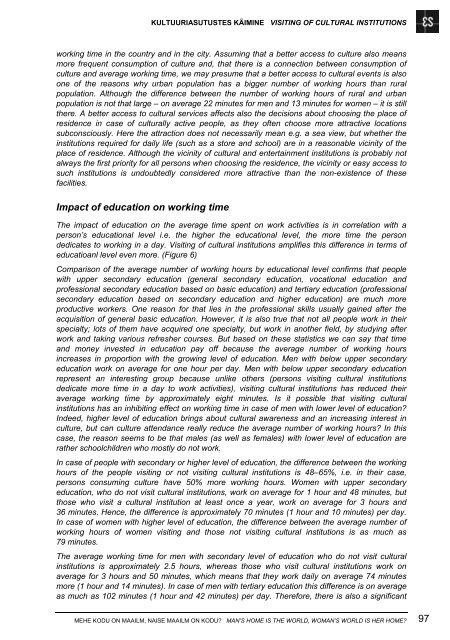MEHE KODU ON MAAILM, NAISE MAAILM ON KODU? - Tartu Ãlikool
MEHE KODU ON MAAILM, NAISE MAAILM ON KODU? - Tartu Ãlikool
MEHE KODU ON MAAILM, NAISE MAAILM ON KODU? - Tartu Ãlikool
Create successful ePaper yourself
Turn your PDF publications into a flip-book with our unique Google optimized e-Paper software.
KULTUURIASUTUSTES KÄIMINE VISITING OF CULTURAL INSTITUTI<strong>ON</strong>S<br />
working time in the country and in the city. Assuming that a better access to culture also means<br />
more frequent consumption of culture and, that there is a connection between consumption of<br />
culture and average working time, we may presume that a better access to cultural events is also<br />
one of the reasons why urban population has a bigger number of working hours than rural<br />
population. Although the difference between the number of working hours of rural and urban<br />
population is not that large – on average 22 minutes for men and 13 minutes for women – it is still<br />
there. A better access to cultural services affects also the decisions about choosing the place of<br />
residence in case of culturally active people, as they often choose more attractive locations<br />
subconsciously. Here the attraction does not necessarily mean e.g. a sea view, but whether the<br />
institutions required for daily life (such as a store and school) are in a reasonable vicinity of the<br />
place of residence. Although the vicinity of cultural and entertainment institutions is probably not<br />
always the first priority for all persons when choosing the residence, the vicinity or easy access to<br />
such institutions is undoubtedly considered more attractive than the non-existence of these<br />
facilities.<br />
Impact of education on working time<br />
The impact of education on the average time spent on work activities is in correlation with a<br />
person’s educational level i.e. the higher the educational level, the more time the person<br />
dedicates to working in a day. Visiting of cultural institutions amplifies this difference in terms of<br />
educatioanl level even more. (Figure 6)<br />
Comparison of the average number of working hours by educational level confirms that people<br />
with upper secondary education (general secondary education, vocational education and<br />
professional secondary education based on basic education) and tertiary education (professional<br />
secondary education based on secondary education and higher education) are much more<br />
productive workers. One reason for that lies in the professional skills usually gained after the<br />
acquisition of general basic education. However, it is also true that not all people work in their<br />
specialty; lots of them have acquired one specialty, but work in another field, by studying after<br />
work and taking various refresher courses. But based on these statistics we can say that time<br />
and money invested in education pay off because the average number of working hours<br />
increases in proportion with the growing level of education. Men with below upper secondary<br />
education work on average for one hour per day. Men with below upper secondary education<br />
represent an interesting group because unlike others (persons visiting cultural institutions<br />
dedicate more time in a day to work activities), visiting cultural institutions has reduced their<br />
average working time by approximately eight minutes. Is it possible that visiting cultural<br />
institutions has an inhibiting effect on working time in case of men with lower level of education?<br />
Indeed, higher level of education brings about cultural awareness and an increasing interest in<br />
culture, but can culture attendance really reduce the average number of working hours? In this<br />
case, the reason seems to be that males (as well as females) with lower level of education are<br />
rather schoolchildren who mostly do not work.<br />
In case of people with secondary or higher level of education, the difference between the working<br />
hours of the people visiting or not visiting cultural institutions is 48–65%, i.e. in their case,<br />
persons consuming culture have 50% more working hours. Women with upper secondary<br />
education, who do not visit cultural institutions, work on average for 1 hour and 48 minutes, but<br />
those who visit a cultural institution at least once a year, work on average for 3 hours and<br />
36 minutes. Hence, the difference is approximately 70 minutes (1 hour and 10 minutes) per day.<br />
In case of women with higher level of education, the difference between the average number of<br />
working hours of women visiting and those not visiting cultural institutions is as much as<br />
79 minutes.<br />
The average working time for men with secondary level of education who do not visit cultural<br />
institutions is approximately 2.5 hours, whereas those who visit cultural institutions work on<br />
average for 3 hours and 50 minutes, which means that they work daily on average 74 minutes<br />
more (1 hour and 14 minutes). In case of men with tertiary education this difference is on average<br />
as much as 102 minutes (1 hour and 42 minutes) per day. Therefore, there is also a significant<br />
<strong>MEHE</strong> <strong>KODU</strong> <strong>ON</strong> <strong>MAAILM</strong>, <strong>NAISE</strong> <strong>MAAILM</strong> <strong>ON</strong> <strong>KODU</strong>? MAN’S HOME IS THE WORLD, WOMAN’S WORLD IS HER HOME? 97

















